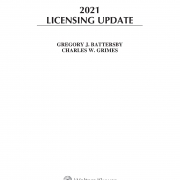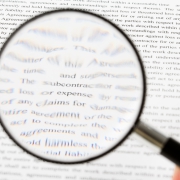Anti-Patent Leadership Taking IEEE-SA on The Road to Knowhere? Part I

The IEEE?
As I noted previously, over the past five years or so, the IEEE has been captured by the implementer lobby and its advocates. But where did this trend originate from? It probably has its roots in its leadership. In 2012, IEEE announced the appointment of Konstantinos Karachalios as its Managing Director.
The announcement boasted Karachalios’ 25 years of experience with the European Patent Office (EPO). However, what it failed to mention, was his long track record of expressing anti-patent positions, which likely held up his promotion and expedited his departure from the EPO.
A review of Karachalios’ tenure at the EPO sheds light on how his initiatives were consistently aimed at weakening protection for standard essential patents (SEPs). For example, in 2009 when still at the EPO, Karachalios gave a presentation in Beijing entitled, The Challenge of Patent Governance in ICT Standards, Seen from a Patent Authority’s Perspective. In it, Karachalios described the interplay of patents and standards (i.e., SEPs) as “the terrain for conflict between the camp of those who want no patents on software and those, who with their IPR, want to exploit their dominant position, either alone or in an oligopoly.” (P2) In other words, he seemed to think that any contributors who want an adequate return on their R&D investment whose proprietary fruits they are willing to contribute towards open standards are by definition “exploit[ing] their dominant position,” i.e. supposedly engaging in illegal anti-competitive behavior. In addition to revealing embarrassing ignorance about basic competition law concepts (to which I return later), the statement depicts a polarized and imbalanced view contrasting those, like Karachalios, who are opposed to software patents, and those who believe in the patent system, who are supposedly “abusive.” As we know, the world and the standardization landscape are more nuanced than that.
Among Karachalios’ other complaints against standards development organizations was that the confidentiality provisions of those bodies removed a whole host of documentation from the universe of potentially novelty destroying materials (i.e., prior art) (p4). Karachalios was instrumental behind the 2009 MoU between the EPO and ETSI which gave the EPO enhanced access to ETSI working group activities so that they can be used as prior art. This MoU opened up masses of prior art previously considered confidential and which very likely one of the factors that led to the common misperception of the poor validity litigation strength of SEPs in Europe.
The MoU was likely claimed to be justified under the confidentiality provision (p38-39) of the ETSI rules of procedure, which notes that any confidential submissions to a working group “shall be regarded as non-confidential by ETSI and its MEMBERS, from the date on which the STANDARD or TECHNICAL SPECIFICATION is published.” But it is worth noting that such materials were previously not generally available to the public. More importantly, courts do not always find that that working group materials become prior art as of the date the technical specification is published, but instead assume their date to be the (earlier) date when the material was submitted to the working group. (See, e.g., ¶¶41-54, where the court considers the dates of the prior art documents to be the dates they were submitted to the various working groups and not the date the specification was published.). As recognized in 2012, the question of what constitutes “confidential or non-public information in the context of standards and standards setting has a strategic impact on the utility of such information in the patent examination process.” (p37)
Having laid the groundwork to make SEPs easier to invalidate in Europe, Karachalios, along with Apple-consultant and ougoing IEEE-SA President Don Wright have been very active in China on SEP matters. Since at least 2008 (p6) both have proactively lobbied Chinese regulators about SEPs. These actions culminated in meetings with China’s NDRC that gave the Chinese regulators more ammunition in their use of anti-trust as a weapon against foreigners. Karachalios’ efforts in this regard – intentional or not – has had the effect of transforming reams of previously unavailable materials directly relevant to SEPs into prior art and also pushing back the prior date of such materials with the net effect of making it easier to invalidate SEPs.
Looking further back into his positions, some 15 years ago Karachalios was a founding member of the Munich branch of ATTAC that has been characterized as an anti-globalization, protectionist NGO. This is not that far off the mark, as in his 2009 presentation in Beijing Karachalios described the existing SEP system as part of what he terms the “Washington Consensus” where the “the setting of standards will remain a battleground between these powerful players. The ultimate reward: the ‘golden patent’ with its potential for technological lock-in.” (p7) Karachalios went on to point to four possible doom and gloom scenarios that are the result of the patent system. He notes: “To put it in a sentence: we think that patent proliferation with many me-too inventions in the field of ICT standards have the potential to lead both systems, standards and patents, into a serious crisis.” (p10) Other than the very odd fact that a then employee of a patent office thinks that there are too many inventions in ICT, he then goes to propose cooperation between standards organizations, competition authorities, and patent offices. Only by so doing government “attenuate rising geopolitical tensions and technological nationalism which threaten to fragment the world again into antagonistic trade and geopolitical blocks.” (p12). All of this seems suitable for an angry founder of an anti-globalization anti-patent NGO. But how does it fit with the values of an international organization aimed at advancing technological innovation for the benefit of humanity? It doesn’t. You cannot “advance innovation” with a biased anti-patents approach that treats any invention as a “me too”. It takes a more nuanced approach to run IEEE-SA.
A similar paradox is reflected in Karachalios’ call for a need for standards bodies to overcome the trend of restricting the flow of information, and how the IEEE (as opposed to other organizations) provides for open participation and collaboration, while performing the real management of the IPR policy behind closed door meetings. Under Karachalios’ watch, the management of IEEE, which used to take place through open boards such as the Standards Board and Board of Governors, has effectively been transferred to the all mighty secret Strategic Planning Portfolio Management Committee (SPCC). The SPCC meets only in closed doors, it doesn’t keep or publish any agendas and minutes and it is conveniently made up of only 5 (!) members that include Karachalios and his side-kick Don Wright. As noted earlier, Karachalios ignorance with respect to competition law, is perhaps what entangled the IEEE in a costly DOJ investigation under his watch. Given DOJ’s focus on good governance and balance, closed door initiatives such as the SPCC may well pave the way for additional investigations.
So how did an international organization focused on innovation come to hire a radical anti-globalization patent hater to manage it, let alone when according to its 2018 annual report 37% of its revenue is derived from proprietary periodicals such as IEEE Xplore?
Life is full of mysteries. The only clear thing is the hope for the broader IEEE organization (beyond the standards association) to wake up and correct this if it wants to have a viable thriving future. Until that happens, it seems wise to stay away from standards such as Wi-Fi, because it is unclear to where the current leadership is taking the IEEE, or how it can “advance technology” or innovation when it is guided by an anti-patent agenda.









